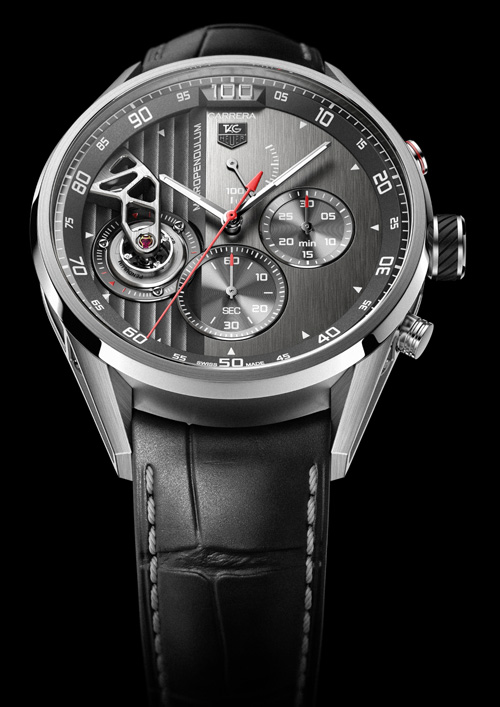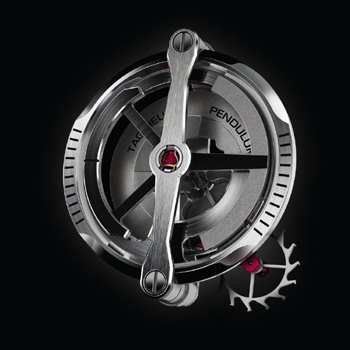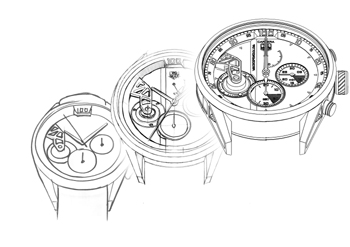In BaselWorld last month, TAG Heuer did what it usually does – unveiled a concept watch. This time it was the extremely avant-garde TAG Heuer Carrera MikroPendulumS Concept watch. Of course, it also unveiled the TAG Heuer Carrera MikroPendulum 100th of a second Chronograph. Confused? We’ll try to explain.
In the world of haute horlogerie concept watches are a must. While they may or may not ever reach the market in serial production – they nonetheless test the invention waters. So many brands (including TAG Heuer time and again) have leapt forward in innovation and technology because they dared to go the extra miles and release to the world a concept watch.
In the case of the MikroPendulum, TAG Heuer turned to micro-blades and magnets instead of hairsprings, and to belts instead of gears. AS such, the brand was able to release the world’s first magnet-driven mechanical watch with 100th-of-a-second chronograph — the MikroPendulum. (Which we describe below) Taking that creation a step further, the brand has conceived of the first-ever double magnetic tourbillon (the MikroPendulumS concept watch).
With nearly a decade of research behind the timepieces – and two years of high-precision MIKRO series timepieces (2011’s Mikrograph and Mikrotimer Flying 1000, and 2012’s Mikrogirder and MikrotourbillonS) – TAG Heuer’s newest evolutions were inevitable.
The new MikroPedulum timepiece has roots in a watch the brand released three years ago—the Carrera Pendulum COSC certified chronometer that used magnets instead of traditional hairsprings. (Essentially the oscillator is driven by magnetic fields instead of a hairspring.) That watch had thermal sensitivity issues and, thus, went back to the drawing board. Throughout the past three years, the brand’s scientist and engineers worked tirelessly to conquer the challenges inherent in using a magnet-driven oscillator. Successful – TAG Heuer’s newest patented MikroPendulum offers breakthrough precision and technology, and is the world’s first high-frequency chronograph regulated by magnets.
Like the other Mikro creations, the MikroPendulum 100th of a Second Chronograph is a dual-chain platform with a balance wheel system – but it features a magnetic system in pendulum shape instead of a hairspring for the chronograph- which beats at 360,000 vibrations per hour (50 Hz). The watch is run on a classic COSC-certified automatic movement powered by an oscillating weight. There are 371 components in the dual-chain structure, each designed, crafted and assembled by TAG Heuer’s Haute Horlogerie team of master watchmakers and engineers. The 45mm case is fine-brushed and polished titanium, with a curved, double anti-reflective sapphire crystal. The anthracite grey dial is fine-brushed on one side with Côte-de-Genève finishing under the pendulum at 9 o’clock. The 100ths of a second are displayed by a sweeping red central hand–and measured out on a 1/100th of a second scale on the anthracite flange.
The Concept watch – the TAG Heuer Carrera MikroPendulumS is another story. This double tourbillon watch — which has received amazing attention thanks to its innovation and its ability to turn a beautiful caliber into one that also is highly functional — is designed to feature two magnetic pendulums to replace the two hairsprings: one for timekeeping and one for time display. The movement has 454 working components and is patented.
Whether or not it goes into serial production remains to be seen, and if so, we will cover it here in much more detail. However, the simple fact that the brand unveiled it – in a revolutionary case material made of chrome and a cobalt alloy – warrants mega attention…. not just now but in the coming year or two.
It is important to note that brands do not have to introduce their concept watches, however, to innovate—and many follow this course. Behind the scenes in their research and development labs, many brands take innovation to new levels – which eventually leads to ever-more-creative technology and timekeeping.










Only one scientist; interesting. Perhaps that’s all they need.
This article missed one elementary point of crucial importance. A pendulum’s restoring force toward its center position is gravity. Plainly, being a wristwatch, gravitational pull varies all over the place. Perhaps it’s the first wristwatch that has to be removed form one’s wrist, and placed in a very specific position relative to gravity, in order to operate?
Sorry, but the article’s failure to note this truly elementary topic makes it suspect.It’s also unfortunate that after reading the article, how the “magnetic pendulum” works is still a serious mystery.
If you want to see a real magnetic pendulum, investigate the device called a ROMP (Randomly Oscillating Magnetic Pendulum), which demonstrates chaos as formally defined. Yes, it does require gravity to operate.
thank you for your comment, I am replying directly onto the post momentarily.
best regards
Roberta naas
This particular reader made me go back and question this post. Thank you for doing that — all journalists cannot operate in a vacuum. However, because I do not want to bring mis-information to my readers — I went back to TAG Heuer directly with my post and with the reader’s comment and asked them to clarify for us all. The answer — from TAG Heuer’s product development vice president follows verbatim:
The term “pendulum” might be confusing for some people as it refers them to a clock. The pendulum in a clock needs indeed the effect of gravity for the weight to push the pendulum one way and for the return to “pull” back the pendulum – In a traditional self winding wristwatch, the effect of gravity is only used to wind the mainspring through the rotor or “oscillating weight” but otherwise has negative effect on the timekeeping – The oscillator in a mechanical wristwatch is made of a ring called “balance wheel” and a “hairspring” to maintain the “return” movement like the gravity on the clock pendulum. Thanks to the hairspring , we have the “back and forth” motion… In order to produce a new regulator using magnets; the shape of the balance changed from a ring to a kind of pendulum shape. The name “pendulum”is referring to the shape of the balance – the magnets are replacing the hairspring – One of the major advantage of the pendulum regulator is the fact that the center of gravity remains the same in different vertical positions – compare to an “off- center” of gravity with a flat hairspring sometimes compensated by a “tourbillon ” cage.
By the way, I did not read anything wrong in Roberta’s article.
Oh one last note – you are absolutely correct in that I accidentally said “scientist” when I meant to say “scientists.” (… the brand’s scientist and engineers worked tirelessly to conquer the challenges … )
MY error. In fact, TAG Heuer’s R&D department consists of multiple scientists and engineers.